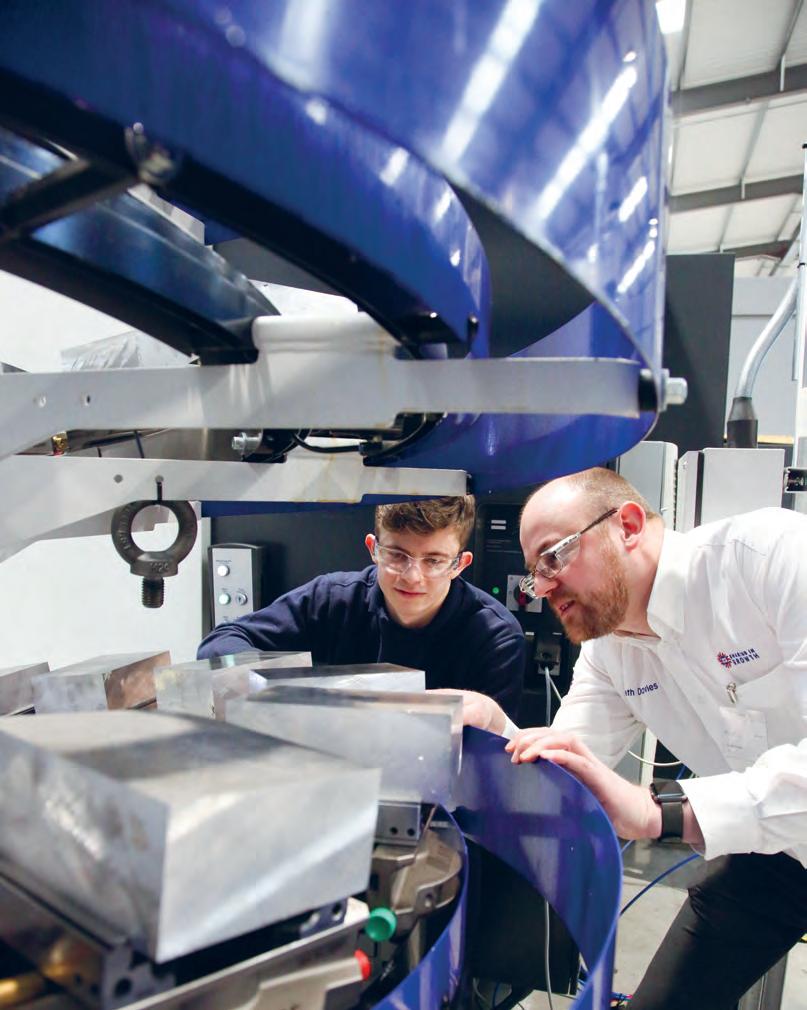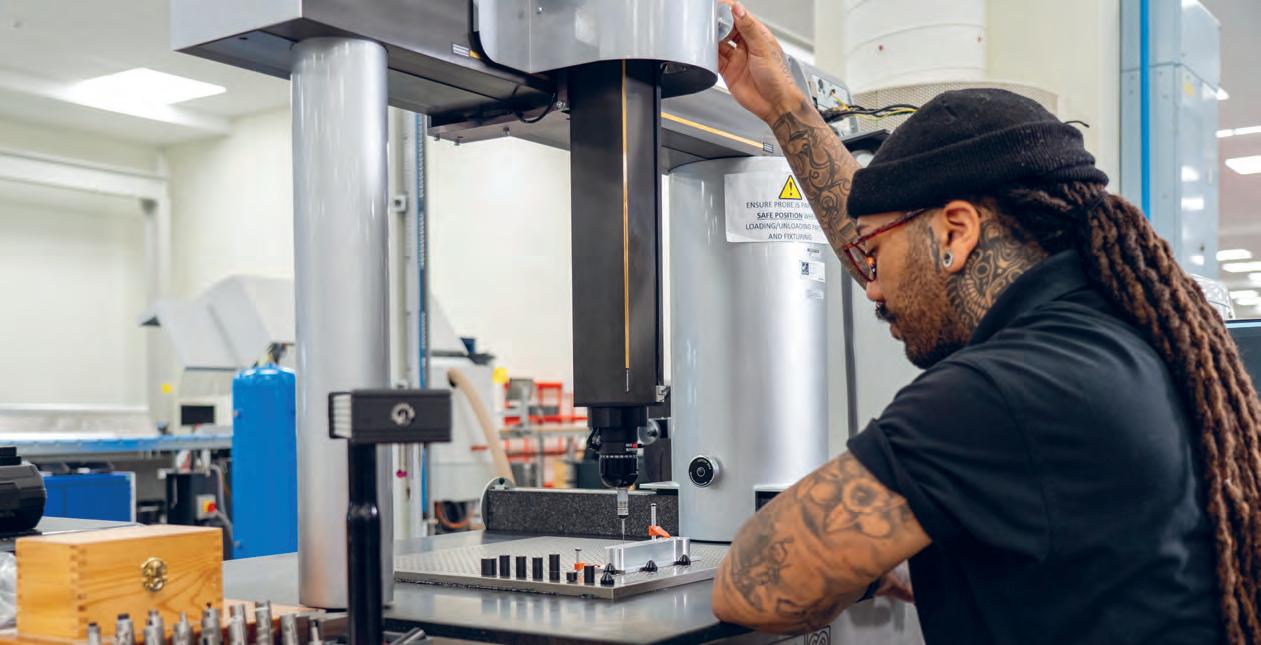
4 minute read
50 NOT OUT
In April, leading manufacturer of measuring and production systems, Renishaw, celebrated its 50th anniversary. The Manufacturer Editor, Joe Bush , paid a visit to the company’s Miskin site in South Wales to find out more about the company’s evolution
Renishaw began its journey back in 1973 when now Executive Chairman, Sir David McMurtry, worked as an Assistant Chief of Engine Design for Rolls-Royce. At the time the company was experiencing a dimensional measurement issue in relation to the manufacture of the Olympus engines that powered the supersonic Concorde aircraft.
McMurtry had a reputation as a great innovator and troubleshooter (in fact, by the time he left Rolls-Royce, he was named on almost 50 patents), and his ingenuity brought about the creation of a prototype touch-trigger probe for co-ordinate measuring machines (CMMs).
The probe not only solved the problem for Rolls-Royce, but also similar challenges being faced by many precision manufacturers around the world, ultimately allowing measurement on CMMs to be automated for the first time.
Following a conversation with John Deer, now Renishaw’s Non-Executive Deputy Chairman, the pair recognised the wider commercial opportunities for the invention and Rolls-Royce agreed to license the
ABOVE: In summer 2022, Renishaw announced a significant new investment at its Miskin site in South Wales, to increase manufacturing capacity and to help meet its net zero emissions targets patent to them but would only do so if they had a limited liability company. For expediency, the pair purchased an ‘off-theshelf’ company and on 4 April 1973, the first Renishaw company, Renishaw Electrical Ltd., was registered.
Although today, a significant amount of Renishaw’s business is still derived from contact and non-contact measurement systems for CMMs and machine tools, the company now supplies a wide range of metrology systems for calibration, position feedback and gauging, plus associated accessories including styli and fixturing. The company has also applied its core expertise in measurement, manufacturing and process control to develop systems for non-destructive testing using Raman spectroscopy, robots and drug delivery systems for brain surgery, and is also a technology leader in the field of metal additive manufacturing (3D printing).
Learning curve
Skilled craftsmen and tool makers made up what was a very traditional CNC environment at Renishaw in the early days. The company is a high variety/ low volume manufacturer and so has a range of different batches of work moving through the factory. In the 1970s and 1980s, this meant extended set times, combined with high quantities of parts, meaning the company’s set to run ratio was high.
“This didn't meet the rate with which we were consuming these components in assembly,” said Paul Maxted, Renishaw’s Director of Industrial Metrology Applications. “We were therefore, tying up lots of machines that were making parts which weren't being used.

“We also had a traditional approach to quality, with a co-ordinate measuring machine (CMM) in the corner of the factory with a traditional inspector who had the responsibility to make sure our quality was being maintained. This made him the busiest person in the factory and created a bottleneck. We also had frequent unplanned quality investigations, and these unforeseen issues were adding cost to us as a business.”
Because Renishaw was designing products that were right on the limits of machine capability at the time, the company also had excessive batchby-batch modification of processes that required regular tinkering from the manufacturing engineering teams.
All these challenges were thrown up at the same time as the company was growing and with it, a requirement for increased capacity. A wide portfolio that included a variety of parts for different products led to high levels of inventory and cost, meaning the company had to become more responsive to assembly demand.
An influx of automation
Renishaw has been on a journey of mass automation adoption since its early days, and this has helped the company deploy machine tools that allow for one hit machining, thus simplifying scheduling throughout the factory.
The adoption of automation systems for part transfer has also allowed Renishaw to leave machines running for long periods with no manual intervention or requirement for raw materials to be replenished. Crucially, the company has also introduced automation in the factory around part setting, batch set up, monitoring processes and the verification of parts.
“It’s been a journey, a key part of which has been rationalising the things we do in the factory,” said Paul. “We've got lots of similar machines which means scheduling is much easier. We’ve also standardised our approach to the machining techniques we use.
“There's very little new process development that goes on - we're just reusing our best practices again and again. This allows us to reduce the amount of time it takes to develop new machining processes for new products.”
Renishaw use a combination of technologies that can be applied to the automation synergy process. Machine performance assessment, on-machine probing and new machine gauging systems allow for closed loop process control, which in turn allows the movement of parts, the interpretation of inspection results and adjustment processes without skilled resources or any manual intervention.
“We manufacture over 70,000 different components and sell over 30,000 combinations of products,” said Gareth Hankins, Head of Group Manufacturing. “In terms of volume and demand, we have a handful of products that we make in the thousands each month, while others are just one-offs.
“So, we have a very broad, medium to low volume manufacturing problem, which makes us quite different. And if we didn't adopt technology around the methods we use to manufacture parts, I can’t begin to think what life would be like. It's enabled us to grow.”
Productive Process Pyramid
To identify and control processes around the factory - before, during and after machining – Renishaw introduced its Productive Process Pyramid. This four-step journey begins with Process Foundation; prior to machining, control of variability and









